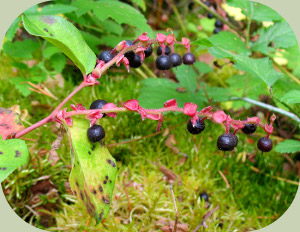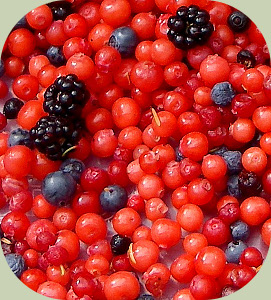Wild Edible Berries

Wild edible berries are a delight to find and to eat! There is a wealth of wild berries throughout North America, and a great number of them grow here in the Pacific Northwest region. Berries come in many shapes, colors and flavors. Here are some details to think about as you go out searching for these wild delicacies.

How nutritious are berries?
Though they are delicious, and fun to collect, edible berries also contain vital nutrients important in maintaining our health. For instance, huckleberries and blueberries contain vitamins E, C & A, as well as small amounts of iron, copper, potassium and calcium. Another member of that genus – cranberries - are high in vitamin C as well as dietary fiber.
Wild berries are a great source of flavor and color to add to many meals and can help encourage greater health when eaten in moderation and as part of a well balanced diet.
In a survival situation, however, it must be remembered that berries are not necessarily enough to keep you going for an extended period. Wild edible berries provide a source of vitamins and a quick boost of sugar. During an extended survival situation, it is also vital to get foods that are richer in fats. Under the duress of a survival situation, eating berries can help keep your physical energy and morale up. If possible, include fat rich foods such as nuts and seeds or possibly wild meats to keep your body nourished.
Where do I look for them?
Wild berries can be found in many different locations, from the wild, forested mountains to the suburban and rural hedgerows. Huckleberries tend to be found in forested areas throughout the Pacific Northwest. Wild strawberries are often found in woodlands, forests and some species even grow on and around coastal dunes. As with other wild foods, be sure to accurately identify the plant and remember to collect them from locations that are clean, and pollution-free. Do not collect from busy roadsides, or near industrial areas were pollutants tend to accumulate.
Wherever you might see them, edible wild berries are a delight to find and to eat. Go out and find some!
How to use edible berries?
Edible wild berries come in a wide variety of flavors, from the mouth-puckering sourness of Oregon grape to the mouth-watering sweetness of wild blackberries. Some species should not eaten raw, but rather cooked down and turned into jam or preserves.
For an excellent pancake recipe, you can throw a few fresh wild blackberries or huckleberries into a pancake mix of your choice. Cook them as you would regular pancakes and add your favorite topping, which might include more wild edible berries.
Be More Prepared For Your Next Outdoor Adventure!

Don't leave home without knowing these six essential survival skills. Our free survival mini guide reveals the strategies of:
- Shelter & fire to prevent the number one cause of death
- Obtaining clean water to avoid life-threatening dehydration
- Common wild survival foods and other critical skills!

What kinds of berries are out there?
There is a diverse range of berries out there, in all kinds of shapes, colors and flavors. Here is a list of the berries found in the Pacific Northwest, many of which are found in other parts of the country as well:
- Salal (Gaultheria shallon)
- Western Tea-berry (Gaultheria ovatifolia)
- Alaska blueberry (Vaccinium alaskaense)
- Oval-leaved blueberry (Vaccinium ovalifolium)
- Black huckleberry (Vaccinium membranaceum)
- Red huckleberry (Vaccinium parvifolium)
- Dwarf blueberry (Vaccinium caespitosum)
- Bog blueberry (Vaccinium uliginosum)
- Evergreen huckleberry (Vaccinium ovatum)
- Bog cranberry (Vaccinium oxycoccos)
- Crowberry (Empetrum nigrum)
- Hairy manzanita (Arctostaphylos columiana)
- Kinnikinnick (Arctostaphylos uva-ursi)
- Blue elderberry (Sambucus caerulea)
- Black elderberry (Sambucus racemosa)
- Saskatoon / serviceberry (Amelanchier ainifolia)
- Salmonberry (Rubus spectabilis)
- Blackcap raspberry (Rubus leucodermis)
- Thimbleberry (Rubus parviflorus)
- Himalayan or Armenian Blackberry (Rubus discolor)
- Evergreen blackberry (Rubus laciniatus)
- Trailing Blackberry (Rubus ursinus)
- Dwarf bramble (Rubus lasiococcus)
- Five-leaved bramble (Rubus pedatus)
- Dewberry (Rubus nivalis)
- Dwarf Nagoonberry (Rubus arcticus)
- Cloudberry (Rubus chamaemorus)
- Creeping Oregon-grape (Mahonia nervosa)
- Tall Oregon-grape (Mahonia aquifolium)
- Bunchberry (Cornus Canadensis)
- Coastal strawberry (Fragaria chiloensis)
- Wild strawberry (Fragaria virginiana)
- Woodland strawberry (Fragaria vesca)
By the way, when you're out foraging for wild plants and mushrooms, it's important to know how to stay safe in the outdoors, especially if you were to get lost. Right now you can get a free copy of our mini survival guide here, where you'll discover six key strategies for outdoor emergencies, plus often-overlooked survival tips.
Further Resources:
Edible Berries of the Pacific Northwest - Northern Bushcraft
For more resources on identifying wild edibles such as edible berries, check out our Wild Edible & Medicinal Plants Courses.
Also, check out some of our other articles on specific berries here: Red Huckleberry Plants and Wild Strawberries.


About the Author: Filip Tkaczyk is a periodic guest teacher at Alderleaf. He also wrote the field guide Tracks & Sign of Reptiles & Amphibians. Learn more about Filip Tkaczyk.
Return from Wild Edible Berries back to Wild Plants Articles
Is The Essential Wilderness Survival Skills Course Right for You? Take the "Online Survival Training Readiness" Quiz
See for yourself if this eye-opening course is a good fit for you. It takes just a few minutes! Get your Survival Training Readiness Score Now!

Grow Your Outdoor Skills! Get monthly updates on new wilderness skills, upcoming courses, and special opportunities. Join the free Alderleaf eNews and as a welcome gift you'll get a copy of our Mini Survival Guide.

 The Six Keys to Survival: Get a free copy of our survival mini-guide and monthly tips!
The Six Keys to Survival: Get a free copy of our survival mini-guide and monthly tips!
Learn more